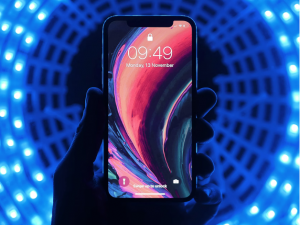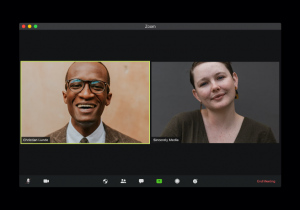28 Video Communication
Ellie Tucker
28.1 Introduction
Keywords
- Interpersonal communication – the process/practice of exchanging ideas, information, and even emotional experiences that can be shared between people
- Video communication – communicating with one or more people using a smartphone, mobile device, webcam, etc., to transmit and receive both audio and video
- Zoom – collaborative video communications program with virtual video and audio conferencing, live chats, screen-sharing, and other features
- FaceTime – video and audio calling app between Apple or Android devices
Learning Objectives
By the end of this chapter, students should be able to:
- Analyze the history of video communication.
- Identify ways that video calls have changed the way businesses communicate.
- Identify ways that video calls have impacted relationships and interpersonal communication.
- Understand the prevalence of virtual communication in society and acknowledge important advancements in video calls.
As the world grows more dependent on technology, communication continues to evolve tremendously. No longer having the need for in-person conversations, society has turned to virtual means of communication. One of the most prevalent forms of virtual communication has been video communication. Video communication refers to the combination of video and audio frequencies that work together to display a conversation that you can see and hear in real time. This technology mimics an in-person conversation like never seen before.
Society depends on these technologies to transcend physical distance. Family members utilize virtual communication programs to keep in touch with loved ones. Similarly, businesses in recent years have placed an emphasis on video communication to promote collaboration amongst remote workers. Collectively, video communication is a useful tool that has the potential to bring people together and encourage conversations. With that being said, virtual communication and video calls in particular have created a space where people and businesses can connect digitally and maintain relationships that would not be feasible otherwise. This form of communication has become our new normal, and industry leading companies continue to make next-generation advancements to their video communication programs.
28.2 What is Video Communication?
Key Takeaway
Video communication refers to the series of audio-visual frequencies that create a video call where users can hear and see one another in real time.
Video communication is extremely prevalent in the way people communicate with one another. It is composed of corresponding audio and video signals that are transmitted and received between technologies. This allows users in different locations to communicate in real time. This audio-visual communication among users, both one-on-one conversations and group conversations, displays a video and audio recording in real time. This allows users to connect digitally as if they were conversing in real life. Video communication programs typically have a feature where you can flip the camera from front to back. This allows people to show their exact point of view through the screen and share real life events as they occur.
Some programs also have a feature that creates the illusion that virtual participants are in the same room, intended to make remote users feel more present in the discussion. A similar feature, breakout rooms, can help facilitate more intimate discussion as well. Breakout rooms are used for small group discussions within large group calls. The technology creates a separate call within the main call, and small group members can converse without the entire group of people hearing. Additionally, many programs contain chat features that allow participants to type messages whenever applicable. Other features promote further interaction among participants and video streamers. Of these, includes a raise hand feature, where participants can click a button that alerts the person streaming the video that an audience member has a question. This sense of virtual interaction among users makes remote communication much more realistic and effective (Borth, 2011).

“A salesperson working in an office on a virtual call” by LinkedIn Sales Solutions is licensed under Unsplash License
28.3 History of Video Communication
Key Takeaway
The first accounts of image transfer as well as wired audio came about in the 1870s, and basic video call communication can be traced back to the invention of the television. The first public account of a videophone occurred on April 7th, 1927. The conversation was between Herbert Hoover (once U.S. secretary of commerce) who was in Washington, D.C., and AT&T (American Telephone & Telegraph Company) officials who were located in New York City (Borth, 2011). This early video communication system implemented standard television equipment using a closed circuit. Initial videophone technologies were also distributed as subscription services in the early to mid-1900s. By 1956, videophones were developed that could be enacted over numerous telephone circuits. Later experimental studies led to the development of an entire videophone system, the Picturephone. Created in 1963, the Picturephone displayed a black-and-white video transmission. This transmission of audio-visual frequencies was like that used in the broadcasting of early televisions.
Though AT&T spent nearly two decades and 500 million dollars in its development, the Picturephone lacked market acceptance. AT&T came to a consensus that their Picturephone was a “concept looking for a market,” suggesting that their invention was ahead of their time. Its failure has also been traced back to poor picture quality, and the Picturephone was ultimately discontinued by the late 1970s. Early video calls were also prominent during the first crewed stage flights within the National Aeronautics and Space Administration. NASA utilized similar frequencies as those of TV Channels. These frequencies were traditionally used when people needed to report information from far distances. These frequencies and satellites would eventually proceed to be normally used within news media. These technologies were very expensive to implement at the time and were not easily accessible to the general public. Video communication at this point was viewed as a luxury, rather than a feasible way to communicate with people.
Costly videoconferencing systems continued to develop during the 1980s-1990s. The addition of Network requirements and software allowed for higher accessibility at a lower cost. In the late 1980s, many companies developed and sold still-frame videophones. Still-frame refers to the frame-capture system, which captures a single video frame for the transmission process. These videophones were able to function directly over the PSTN, or public switched telephone network (Borth, 2011). Of these numerous advancements, one of the most notable was the world’s first color videophone. Introduced in 1993 by AT&T, the Videophone 2500 could transmit synchronized video and voice frequencies over telephone lines. In the late 1990s, video communication began to pick up speed in the business setting, as it allowed for conferences without the burden of travel.

“iPhone” by Youssef Sarhan is licensed under Unsplash License
28.4 Impact of Video Communication on Society
Key Takeaway
With 42 percent of employed Americans working full time from home, video communication has taken over the business industry. These virtual substitutes help companies increase revenue while lowering costs and are reshaping the future of office work. Additionally, remote workers can avoid the hassles of commuting and are offered a more flexible workday at home. Many businesses have implemented collaborative tools such as shared digital whiteboards, live co-editing documents, virtual offices, and focus groups. Creating a productive atmosphere where workers can actively participate and converse with one another, these technologies can help remote workers feel less isolated from their companies and coworkers. The video, audio, and chat features allow for ample communication among colleagues. These features have served to promote further discussion and encourage all team members to use their voices. This gives workers with less-prevalent voices the opportunity to feel heard (Murray, 2020). One of the main program’s businesses utilize is Zoom Meetings, which is a video teleconferencing software program developed by Zoom Video Communications. The program is free and allows up to 100 concurrent participants. Programs like these allow businesses to communicate face-to face in a sense, despite the psychical distance (Caminiti, 2021). This can promote a sense of inclusion and diversity in the workplace as colleagues have the potential to make cross-cultural connections like never before (Wankel, 2016).

“Zoom (Video chat)” by visuals is licensed under Unsplash License
Expanding from advancements in the workplace, technology as a whole has encompassed our lives. The prevalence of technology has had enormous impacts on interpersonal communication, which refers to the exchange of information between two or more people, and how they use verbal and nonverbal cues to accomplish personal or relational intents. With more and more interactions being held virtually, people are becoming accustomed to communicating via text, call, or video call. The lack of interpersonal communication in recent years has raised questions regarding technology’s impact on social skills. In particular, how video communication has impacted our ability to recognize non-verbal cues and behaviors, form and maintain social relationships, and participate in social groups. This theory is rooted in the fact that humans who use more screen time are simply less experienced in dealing with face-to-face interactions (Bohn, 2021). Alternate theories suggest that virtual communication may enhance social interaction as it can provide a comfortable atmosphere to analyze the verbal cues being transmitted and received within the conversation (Ruben et al., 2021).
A notable result of video communication is the way we can develop and maintain relationships, regardless of physical distance. This sense of connectivity has become crucial in our lives as these video calls resemble face-to-face interactions and can help us keep in touch with loved ones who are far away. FaceTime, a video and audio calling app between Apple or Android devices, is a popular video communication program that families can use to communicate with their relatives. In addition to FaceTime, many families choose to connect over a program referred to as Skype. Skype is a video chat and instant messaging computer software program. These programs have the potential to “transcend” real life distance by creating emotional ties through the screen (Blunden, 2020).

“Time together on the couch” by Alexander Dummer is licensed under Unsplash License
28.5 Future Outlook on Video Communication
Key Takeaway
The video communication industry has come a long way and is continuing to evolve. Industry-leading video communication programs are promoting product differentiation through the addition of unique features to their existing applications. One of the next-generation applications being implemented is spatial audio. Spatial audio is a three-dimensional audio effect that can make video calls sound much more realistic. Three-dimensional audio effects are a group of sounds that manipulate the audio released from various speakers or headphones. This typically involves the virtual arrangement of sound sources anywhere in a three-dimensional, confined space. The audio can be placed behind, above or below the listener, mimicking the way sounds bounce within a room. The volume of frequencies adjusts proportionately with your movements, as they would in a real-life conversation. Many companies have begun to implement spatial audio to improve the aroma of their online meetings. For instance, Apple recently released a new line of products that automatically support spatial audio. In the future, we can expect these new spatial audio tactics to become a normalcy across most video communication platforms.
Considering the recent pandemics and society’s overall dependence on video communication, we can surely expect these programs to improve their dependability in the coming years. When people (or businesses in particular) choose their applications for video conferencing, dependability and quality are typically deciding factors. As industry leaders compete within the video communication industry, video and audio quality are crucial. Some video communication companies have mentioned the use of artificial intelligence technology to create next-generation video and audio advancements. Zoom has begun to implement a feature referred to as live video editing, which is a way to edit videos without the need for prerecorded footage. Their live video editing has several components, including a skin smoothing feature along with features that can change the background of your recorded meeting (Murray, 2020).

“Business meeting” by Jason Goodman is licensed under Unsplash License
Case Study
Pew Research Center, a nonpartisan fact-tank that informs the public about issues, attitudes and trends shaping the world, conducted a case study where they asked individuals how digital life has impacted them personally. A substantial share of participants in this study recited their own experiences and concluded that virtual communication improves several dimensions of their work and home lives.
Many participants highlighted how video communication has particularly impacted their lives. One of them being Paul Saffo, a leading technological forecaster and consulting professor at Stanford University. Paul said, “The net effect of these innovations has been to tie me more closely to other individuals and extend my interpersonal connections well beyond the pre-internet links of in-person interactions and telecommunications. I have friends – close friends who I have known for well over a decade and with whom I communicate nearly every day. At the end of the day, the two of the three highest human desires are the desire to be useful, and the desire to share stories.” Similarly – Kyle Rose, an architect at Akamai Technologies, recounts ways that virtual communication has helped him maintain relationships that would not be feasible otherwise. He states, “I can more easily keep in regular contact with friends in distant places. Those with whom I would have lost most contact (because, really, there’s no way I’m going to write letters or spend hours on the phone) I can now maintain a relationship with, sometimes of a fairly deep and interactive nature, via social media. This enables us to pick right up when we do finally see each other in person.” These specific accounts demonstrate how video communication can facilitate and maintain meaningful relationships.
Other participants acknowledged how video calls have changed the way they communicate in terms of business. One of them being Larry Irving, co-founder of The Mobile Alliance for Global Good. Larry highlights how normal it is nowadays to connect with business partners virtually. He said, “I have numerous meetings with people I don’t know or only met once or twice previously. Recently I had a meeting with someone I didn’t know well.” Additionally – William Schrader, the founding CEO of PSINet, discussed the cross-cultural connections that he was able to develop through means of video communication. He stated, “Every single day: I have private communications with business associates in Europe, Asia, Latin America and in North America.” These accounts reveal the potential for video calls to foster connectivity and collaboration throughout the world (Anderson & Rainie, 2018).
Chapter Summary
Video communication refers to the series of audio-visual frequencies that create a video call where users can hear and see one another in real time. The concept of video calls originated from initial image transfer and audio techniques that are consistent with early televisions. These techniques have since developed into modern cell phones and computers capable of complex video communication. Society has since become dependent on virtual means of communication, and video calls have redefined how businesses operate, have impacted how we perceive behavioral cues and have increased connectivity regardless of real-world distance. Video communication programs continue to place an emphasis on improving audio and video quality in the coming years, and we can expect an even greater presence of these technologies in the future.
Review Questions
1. Basic video call communication can be traced back to the invention of the _________.
A. telephone
B. telegram
C. television
D. iPhone
2. The exchange of information between two or more people refers to __________.
A. Direct Communication
B. Virtual communication
C. Interpersonal communication
D. Communal communication
3. Which of these is NOT a program used for video calls?
A. Instagram
B. FaceTime
C. Zoom
D. Skype
4. In the late 1980’s, many companies developed and sold ______ videophones.
A. Rapid-frame
B. Still-frame
C. Same-frame
D. Multi-frame
5. An audio feature that many industry leaders plan to implement in the future is ________.
A. Spatial audio
B. 3D audio
C. Programmed audio
D. Quick audio
Answers:
- C
- C
- A
- B
- A
Food for Thought
- Do you foresee a decline in social skills regarding future generations as we become more accustomed to virtual means of communication?
- What are some ways in which video communication programs like Zoom can increase audience engagement?
- Recall a time where someone misunderstood something you said. Reflect on the importance of behavioral cues and how they correspond to the productivity of video communication.
References
Anderson, J., & Rainie, L. (2020, August 17). Stories from experts about the impact of digital life. Pew Research Center: Internet, Science & Tech. https://www.pewresearch.org/internet/2018/07/03/the-positives-of-digital-life.
Blunden, M. (2020, June 24). Mirroring body language “helps distant facetime families feel closer”. London Evening Standard. https://www.standard.co.uk/tech/facetime-video-calls-families-mirror-body-language-a4453941.html.
Bohn, K. (2021). How social media is changing the way people get to know one another. Penn State University. https://www.psu.edu/news/research/story/how-social-media-changing-way-people-get-know-one-another.
Borth, D. E. (2011, February 17). Videophone. Encyclopedia Britannica. https://www.britannica.com/technology/videophone
Caminiti, S. (2021, July 15). Here’s how Zoom is helping create the new world of hybrid work. CNBC. Retrieved November 17, 2021, from https://www.cnbc.com/2021/07/15/heres-how-zoom-is-creating-the-new-world-of-hybrid-work-.html.
Murray, E. (2020, October 13). The next generation of office communication tech. Oliver Wyman – Impact-Driven Strategy Advisors. Retrieved November 18, 2021, from https://www.oliverwyman.com/our-expertise/insights/2020/oct/the-next-generation-of-office-communication-tech.html.
Ruben, M. A., Stosic, M. D., Correale, J., & Blanch-Hartigan, D. (2021). Is technology enhancing or hindering interpersonal communication? A framework and preliminary results to examine the relationship between technology use and nonverbal decoding skill. Frontiers in Psychology, 11(1), 611-670. https://doi.org/10.3389/fpsyg.2020.611670
Wankel, C. (2016), Developing cross-cultural managerial skills through social media, Journal of Organizational Change Management, 29(1), 116-124. https://doi.org/10.1108/JOCM-11-2015-0225
Communicating with one or more people using a smartphone, mobile device, webcam, etc., to transmit and receive both audio and video.
A video platform that allows up to 100 people to be on video at the same time.
The process/practice of exchanging ideas, information, and even emotional experiences that can be shared between people.
Video and audio calling app between Apple or Android devices.

